Bicycle Glossary A B C D E F G H I J K L M N O P Q R S T U V W X Y Z
Bicycle Glossary - C
![]()
Cable - As applied to bicycles, this means a mechanical control conduit. By use of a cable when you operate a shifter or a brake lever, your energy is transferred to a derailleur or brake, even though the handlebar might be turned. The cables consist of a casing, also known as "housing," and an inner wire. While the inner wire is pulled by the control lever, the casing is correspondingly compressed. The casing is usually made as a tightly wound spring, coated with plastic. Cables have the interesting characteristic that if even one strand has broken, they have less than a half of their original strength. Replace cables as soon as you suspect any weakening.
Cable carrier - A small metal plate with a hooked surface and an anchor bolt. This is used with cantilever and centerpull brakes to attach the main brake cable inner wire to the straddle wire. Synonym: Yolk.
Cable guide - A small bracket bolted or brazed on as part of the bicycle frame, or occasionally attached elsewhere which guides a cable or cable inner wire around a bend.
Cable housing, a cable's stationary outer layer. - see Cable.
Cable stop - A small bracket bolted or brazed on as part of the bicycle frame at which a control cable's casing stops, but through which the inner wire continues.
Cable tie - A device which keeps control cables from flapping around or hanging loose. Cable ties can be elaborate, such as chrome-plated, bolted-on steel brackets, or ugly but adequate such as a layer of electrical tape or a tie-wrap.
Caliper brake - A brake which stops a wheel from turning by squeezing friction pads against the side of the rim.
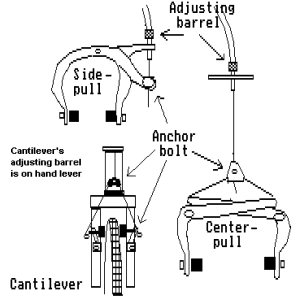
Campagnolo - An Italian manufacturer most known for their derailleurs, shifters, brakes, cranksets, bottom bracket sets and headsets. Campagnolo components are seen mostly on road bicycles, and are regarded as top of the line. They also manufacture entry-level components, but these are seldom seen in America. One of the distinguishing factors of Campagnolo's line of components is that replacement parts are available. For instance if you need one bearing cone for a rear hub, it can be ordered as a separate part.
Web site: www.campagnolo.com
Campagnolo tool set - A kit of high-quality tools including alignment gauges and threading taps for bicycle repair. Most of the tools are for frameset repair.
Web site: www.campagnolo.com
Cantilever brake - A type of caliper brake in which each side of the brake pivots on a post which is part of the bicycle frame or fork. For fat tire bikes the cantilever brake is superior to sidepull or centerpull brakes because the extra length of the arms necessary to accommodate the fat tires causes the brakes to be prone to too much flexing.
Carbo-loading - A technique in which a racer eats lots of carbohydrate-rich foods for a day or two before a race, figuring that the extra carbohydrates will offer more energy. Not all racers and people who study performance and diets agree that this is the best strategy.
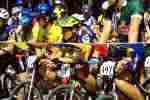
Carbon fiber - Also known as 'graphite,' this material is light and strong, and has been used as bicycle frame tubing.
Carpal Tunnel Syndrome - A condition in which the little finger and half of the ring finger become numb. This is because the nerve which runs through the junction of the palm and wrist is compressed against the handlebar or grip. This is harmless if it happens once, for a short period of time, but should not be ignored because it can become chronic. Immediately experiment with other grips, handlebar position or handlebar style to eliminate the problem.
Cartridge bearing - A bearing that is self-contained, and cannot be easily disassembled. Most cartridge bearings are sealed against dirt and moisture. Traditionally, cartridge bearings have been made to greater precision and with greater durability than bicycle cone-and-cup bearings. An example of cartridge bearings are the ones used in roller skates and inline skates. Cartridge bearings are starting to appear in bicycles more than ever before.
Case-hardened - A steel part that was packed in carbon as it was formed. This process gives the outer surface of the steel part great strength and wear resistance, but also greater brittleness. If a case-hardened part is ground down or chipped it should be replaced because the metal underneath is much weaker.
Casing - Cable casing - see Cable.
Cassette - A type of multi-speed freewheel that is mounted to the rear hub via splines and a threaded retainer. Traditional freewheels mount to the rear hub using fine threads, and can be difficult to remove because hard riding screws the freewheel very tightly onto the threads. On most cassettes, the sprockets are also mounted onto the cassette with splines, although the smallest sprocket or two are often threaded onto the cassette.
Cassette hub - A rear wheel hub that works with a cassette freewheel. Sometimes the combination of hub and cassette are called 'cassette.'
Centerbolt - the axle that upon which a sidepull brake mounts and pivots.

Centerpull brakes - A style of caliper brake on which the brake arms pivot on either end of a plate which is mounted to the frame or fork by a single, center bolt. Centerpull brakes are common on thin tire bikes.
Centerpunch - A device much like a hard nail with a handle on it. This is used with a hammer to make marks in metal. See also Pin punch. Centerpunches are often used to make a dent before drilling a hole so that the drill bit doesn't wander.
Centimeter - A unit of linear measurement used in most countries other than America and the British Empire. There are 2.54 millimeters in an inch, so five centimeters is approximately two inches. Centimeter is often abbreviated as cm. Click here for centimeter to inch conversions.
Century - A ride which covers one hundred miles within one day. Double-centuries cover two hundred miles, and triple-centuries cover three hundred miles in one day. Not many people can complete triple-centuries.
Chain - A series of links to conduct power from the pedals to the rear wheel. Half of the parts of which a bicycle are composed are the chain. Chains used on bicycles with a single sprocket at the rear wheel are called "eighth-inch" because the width of the sprocket teeth they accommodate is one-eighth of an inch. Chains on derailleur-equipped bikes are usually "3/32."
The chain is a high-maintenance item. It requires lubrication to avoid rapid wear, and reduce friction which can slow your ride. Yet, most lubricants attract dust, and the chain is located where lots of dust is found - near the ground.
1/8" chains have a master link, a single, special link which can be removed with ordinary tools. 3/32" chains do not have master links, all the links are the same. To remove a 3/32" chain for cleaning, a special tool is available at bicycle shops called a "chain tool" or sometimes "chain breaker."

Chainguard - A metal or plastic plate to protect the rider from the chainwheel and chain. The rider would prefer not to get any grease on legs or clothing, and does not want to get clothing stuck in the chain and chainwheel. There are two kinds of chainguards ones which are large and fastened to the bicycle frame to cover the chainwheel, and rotary ones which are mounted to the chainwheel and turn with it. The rotary ones are not as effective, but weigh less and are less likely to need maintenance. Most serious cyclists do not use chainguards. They do not like the weight or complexity.
Chain link - One segment of chain. Although there is no consensus on how much of a chain 'one link' is, generally, it means a section consisting of one outer 'link' and one inner 'link,' so that you have the minimum amount of chain that can be removed or added and still have a continuous loop of chain when you're done.
Chain lube - An oil to lubricate chains which tends to collect less dust and dirt than conventional oil. See Lubrication for more details.
Chainrings - Sprockets which are mounted on the crank. An assembly of chainrings and possibly a chainguard is called "chainwheel."
See also: Crank, Bottom bracket.
Chainring tattoo - An oily, black mark left on the rider's leg from touching the chainwheel. Synonym: Grease tattoo.
Chain skip - An undesirable effect in which when pedaling hard, a skip is felt as if the chain is skipping one link ahead from time to time. The problem may be a stiff chain link, a worn out freewheel or a problem with the crank or chainwheel. To diagnose the problem:
If the skip happens one for every revolution of the crank, then look for problems in the mounting of either crank on the bottom bracket spindle, loose chainring bolts, or a problem with the chainrings themselves. If the bike has a rotary chainguard, perhaps it is bent and interfering with the chain.
If the skip happens once for every revolution of the rear wheel, there may be an accumulation of dirt or another problem relating to the freewheel.
If the skip happens once for each revolution of the chain, then the problem is definitely related to one chain link. (This could be dangerous if ignored.)
If the skip happens randomly, but especially on the smallest freewheel sprockets, the chain and freewheel are most likely worn out. This problem is not dangerous, but it will slowly progress.
Chainstay - A portion of the bicycle frame which extends from the bottom bracket housing (center of the crank) to the dropout (where the rear wheel is fastened). There are two chainstays on almost all bicycles.
Chain tension - 1. In the case of derailleur-equipped bikes, the chain tension is the amount of spring in the part of the rear derailleur which wraps up excessive chain length. The tension in many derailleurs is adjustable, but seldom is it necessary to change the tension adjustment. 2. In all non-derailleur bikes, if the rear wheel is installed too far back, the chain tension will be too tight, causing rapid wear of rear hub or bottom bracket bearings, and more friction. If the wheel is too far forward, the chain tension will be too loose, risking that the chain can fall off the sprockets. Because chainwheels are not perfectly round, you may have to settle for a chain tension which is reasonably loose at one part of the chainwheel rotation, but a bit tight at another point in the rotation.
Chain tool - Since 3/32" chains, those used with derailleurs, have no master link, a special tool is required to remove, install or repair chains. This tool drives any rivet most of the way out of any link so the chain can be separated. The rivets are friction fitted, so to reinstall a chain, you just drive the rivet back into position. The link may be stiff after installation, so gently bend it back and forth laterally (against its usual direction of movement) to free it up. Do not drive a rivet all the way out, but instead, just enough to allow the chain to come apart, because it is nearly impossible to get the rivet installed again.
Portable chain tools are very small and light, and quite inexpensive. In a pinch, chains can be repaired without a chain tool. You can set the chain over a hole in a workbench, and drive the rivet most of the way out with a hammer and nail. Reinstall the rivet by gently pounding it back in with a hammer.

How-to: Chain repair
Chainwheel - The sprockets and any related hardware which mount on the cranks, including chainring bolts and rotary chainguard if one is present. Chainwheel can also mean a single sprocket mounted on the crank.
Chain wrench - A tool consisting of a handle and a length of bicycle chain. Used in combination with another chain wrench or a freewheel vise, it is used to remove sprockets from rear wheel hubs or freewheels. Also known as a chain whip, or sprocket wrench.
Channellocks - Tongue and groove pliers - which see. Channellock is a brand name which has been used generically.
Child carrier - Synonym: Baby seat.
Child Stoker Kit - A recently popular innovation which attaches to ordinary bicycles. It is a wheel, crank and pedals, seat and handlebar which follow the bicycle, and carry a child, who can contribute to the motive power of the ride. Child stoker kits are often seen attached behind tandem bicycles.
Children - Things which often ride bicycles. Children require special care. You don't want them to get hurt, or even
be disappointed. Therefore, it is well worthwhile to:
* Make sure they know about bicycle safety if they ride in traffic.
* Make sure they know what injury is, and that they are not invincible.
* Provide bicycles that are always in safe working condition.
* Make sure they understand that motorists expect predictable behavior.
* Provide bicycles that are not way too large for the rider.
* Have them wear appropriate bicycling clothing. This means pants or skirts which will not get caught in the chain, and protective gear unless they are riding in very safe environments. If riding in traffic or among other riders or pedestrians, the clothing should be colorful.
Chrome - also known as Chromium, a hard, bright, brittle metal that does not rust. Steel is often plated with chrome for weather resistance. When chrome-plated steel rusts, what is actually happening is that the steel underneath is rusting, and leaking through cracks in the chrome. Rusty chrome-plated steel can be de-rusted by rubbing with soapless steel wool - available in hardware stores. Be careful when rubbing chrome-plated steel, because the chrome can flake off in very sharp chips, resulting in cut fingers.
Circus bike - A bicycle on which a performer can do tricks. Most circus bikes have fixed, one-to-one gearing so the performer can ride it like a unicycle and go backwards. The forks are straight, there are no control cables to the handlebar and the toptube is long so that the handlebar and front wheel can be spun around and around. Many circus bikes are also fall-apart bikes. By flipping a lever or two, parts appear to fall off, which children find very entertaining.
Classic - A bicycle made during the 1940s, 1950s or 1960s, or a replica. The classic typically has fat tires, chainguard, fenders, wide handlebars, a coaster brake, curved frame tubing, and one or two speeds. It may also have a fake motorcycle-like gas tank. In the case of two-speed classics, the gearing is a planetary gear set in the rear hub along with the coaster brake mechanism. True classics are valued antiques. A bike generally qualifies as a classic if it is at least 25 years old. A quick way to see if a bike is a classic or a replica is to note whether the pedals have reflectors. (At least you'll know whether the pedals are old or not).
See also: Antique.
Cleat - A plate fastened to the bottom of a special cycling shoe to create a secure attachment to the pedal. There are several types of cleated shoes, but most are not so secure that you can't quickly remove the foot laterally, or reach down, loosen a toe strap and get out.
Clincher - A term given to a conventional bicycle tire, especially used to differentiate between thin, high-pressure conventional tires, and sew-up tires. The clincher has a U-shaped cross-section, which with the help of the wheel rim, encloses an inner tube to hold compressed air. Built into the edges of the tire, and invisible unless you cross-section a tire, are thin steel cables, one on each side, to keep the tire from stretching and blowing off the rim when the tire is inflated. These are called "beads" or "the bead."
Coaster Brake - A brake built within the hub of the rear wheel. The coaster brake is actuated by pedaling backward an eighth of a turn or so. The coaster brake is nearly maintenance-free and very reliable. However in an emergency stop, it is best to have a front brake also, because in a quick stop, most of the weight transfers to the front wheel, and the rear wheel with a coaster brake will skid for a long distance. Coaster brakes are usually found on single-speed bikes, but three-speed bicycles are made with a three-speed planetary gear set and coaster brake all in the same hub.
Coasting - The act of riding without pedaling. Coasting downhill is great, and you can coast for a while on flat areas if you have built up some speed, but coasting uphill doesn't last very long.
Cog Tool - A tool with which you can grasp the core of an old-style non-cassette freewheel and unscrew it from the hub of a rear wheel. Synonym: Freewheel remover.
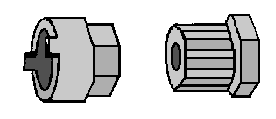
Combination wrenches - Wrenches with a box on one end and open on the other. See also: Box-end wrenches, Open-end wrenches, Socket sets.
Commuter - A rider who uses a bicycle to get to and from work or school.
Complete overhaul - See Overhaul.
Cone and cup bearing - a standard bicycle ball bearing assembly consisting of a cone, the steel balls, a cup and adjustment hardware.
Cone - see bearing cone.
Corrosion - Many metals can combine slowly with oxygen, and become corroded. In the case of steel, this is rusting. Corrosion is enhanced on bikes that are left out in all weather, and on bikes that are exposed to salt from salted winter roads, or by being near a beach.
Cotter - See Cottered cranks.
Cottered Cranks - A system in which the cranks are held to the axle by soft steel bolts which have a tapered flat side. These bolts are called cotters. The bottom bracket spindle upon which the cranks mount have one flat surface on the left side of the bicycle, and a flat surface half-way around the spindle on the other side of the bicycle. The cranks have a hole so they can slip onto the bottom bracket spindle, and then another, smaller hole drilled transversely through the crank. The cotter is inserted into this transverse hole to hold the crank on the bottom spindle, and prevent it from turning relative to the spindle.
Cotters become worn, and should be replaced as soon as any clunking or slippage is detected. The slippage always feels like it is on the left side of the bike, but can be on the left or right side.
To remove a cotter, take off the small nut and washer which secure it, and hit the threaded end lightly with a hammer. If you are lucky it will pop out before the threaded end is damaged. Applying a small amount of heat to the crank can help, but be careful not to boil the grease within the bottom bracket or damage the paint of the bicycle. If the cotter stubbornly refuses to be removed, you may have to drill into it with a 1/4" drill bit to allow it to collapse inward on itself enough to come loose. Be careful not to let the drill bit get into the crank or bottom bracket spindle. When the cotter is mostly drilled, you can set a large nail or pin punch into the hole, and can then easily drive it out with a hammer. To prevent stuck cotters in the future, grease the surface of the new cotters.
To install a cotter, place it in position, and tap its blunt end lightly with a hammer. Tighten the cotter nut, and then tap the blunt end with a hammer and tighten the nut again. Be careful about over-tightening the nut, the cotter is made from soft metal.
Cottered cranks are rather maintenance prone, and are therefore being rapidly phased out with cotterless and one-piece ("Ashtabula" or "American" cranks).
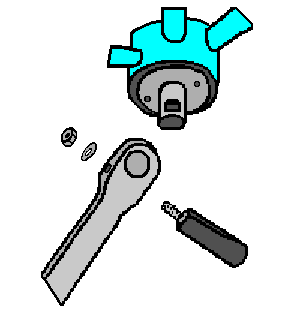
Cotterless cranks - These cranks mount on tapered square-ended bottom bracket spindles. On the end of the spindle is a nut or bolt which keeps the crank secure. These fasteners should be checked for tightness from time to time, especially in the winter. If a cotterless crank comes loose on the bottom bracket spindle, it will almost surely need to be replaced, since it wears itself out of shape quite rapidly.
The best way to remove a cotterless crank is with a cotterless crank remover. This is a small tool
that has a threaded portion that fits into the threads which normally hold a dust cap over the fastening nut or bolt. After removing the dust cap and nut or bolt, screw the crank remover as far as it will go into the dust cap threads. It should go in several turns. Then screw in the inner portion of the tool which will press against the bottom bracket spindle, thereby pulling the crank off.
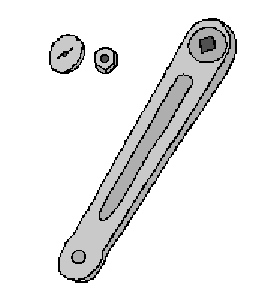
Countersink - To round the edges of a hole. The most talked-about example is countersunk spoke holes in hub flanges. Because of the countersinking, the spokes are not subjected to as much stress where they come out of the spoke holes. If the holes were not countersunk, spokes would be more likely to break because of the continuous load-bearing contact with the sharp edges of the spoke holes.
Crank - The assembly on which the pedals are mounted. Technically, the crank is a set of two crank arms, which mount on a "bottom bracket spindle" or the crank is a one-piece dog-leg shaped casting which includes the bottom bracket spindle in the case of most American-made bicycles. But the term "crank" is often applied to the whole works, including bottom bracket bearing set, crank arms and chainrings, or just the cranks and chainrings.
Crank cotter - See Cottered cranks.
Crankset - Crank arms and chainrings.
Creep - verb. Creep occurs when a tire slowly rotates around a rim. This is a very uncommon phenomenon, mostly seen with sew-up tires which are not glued well upon hard braking.
Crescent wrench - An adjustable wrench. Crescent is a brand name which has been used generically.
Tip: More information about Crescent wrenches.
Crossover gear - When the chain is engaged on the smallest front sprocket and the smallest rear sprocket, that is called 'crossover gear.' Note that crossover gear is not your highest or fastest gear - that would be the largest front sprocket turning the smallest rear sprocket. Crossover gear is an expensive combination because it greatly shortens chain and sprocket life. The smallest front sprocket transmits the most power to the chain. The smallest rear sprocket has the fewest number of teeth to eat that power. Therefore, great force works to wear the chain links and sprocket teeth. Another gear combination, involving sprockets that are larger, will give you almost the exact same gearing, but will not damage the chain and sprockets. The same concept applies to nearly crossover gears as well. In general, the rider should avoid any combination of small front sprockets and small rear sprockets at the same time. Crossover gear presents two other problems. The chain is in its most slack position, which causes problems with some derailleurs. Also, the chain really does cross over. The chain is being pulled slightly sideways, which can cause rubbing on the front derailleur cage, a chain that wants to fall off, or shift automatically to another front sprocket, and wear on the sides of sprocket teeth, and on the internal parts of the chain.
Cruiser - A bicycle that has fat tires and wide handlebars. Beyond that, the exact definition is hard to pin down. A cruiser may or may not have curved frame tubing. A cruiser may have a coaster brake, or have five or more speeds. A cruiser may or may not have front suspension. A cruiser may or may not have fenders. See also: Classic.
Cup - see bearing cup.
Cyclocross - An off-road competition done with light-weight, thin-tire bikes. Many cyclocross races involve riding through mud, and sections where the bicycle must be carried. Picnic tables make a typical cyclocross obstacle. Cyclocross predates mountain biking by almost one hundred years.
CyclePro - A brand name of West Coast Cycle, a wholesaler of bicycles and parts and tools.
Cyclometer - A meter that indicates how many miles the bicycle has traveled,
also known as 'odometer.' Some cyclometers have a computer chip, and a battery-powered display. They measure distance by feeling an electrical field generated as a magnet mounted on the spokes goes past a pickup mounted on the fork. Others are mechanical. The most common
mechanical type have a small spike mounted on a spoke, which turns a gear a little bit every time the spike goes by.
![]()
Anything missing or need greater coverage? Let me know - Jeff
Tell a Friend About BikeWebSite
Please feel free to link your web pages to www.bikewebsite.com.
Disclaimer
Although I have attempted to cover the major safety issues, I cannot be responsible for your use of this information. Working on bicycles is dangerous if you do it without considering consequences of bolts left loose, known problems which are ignored, things which should be replaced but are glued instead, and so on. Proceed carefully at your own risk and use common sense. Jeff Napier, and all agents associated with this information, do not offer any guarantee or warranty for your use of this information.
Copyright © 1991-2014, bikewebsite.com